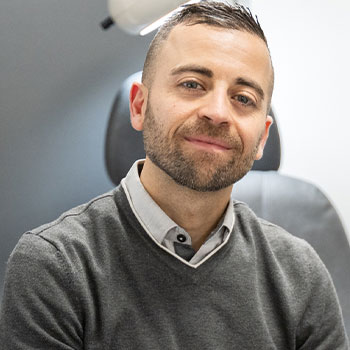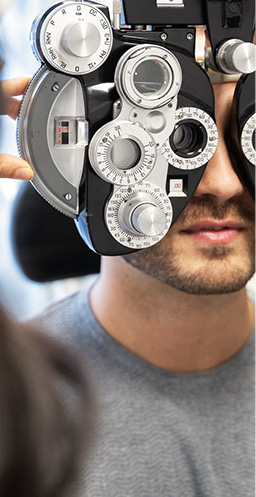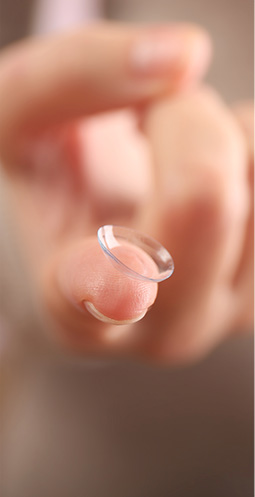Dry eye is one of the most common eye conditions affecting millions of people worldwide. In addition to frustrating irritation, it can cause a wide range of issues that affect your vision. It’s no wonder some people ask if it can cause blindness.
Dry eyes don’t directly cause blindness, but they can increase your risk of infections and other complications that could cause vision loss if not treated promptly. The answer isn’t as straightforward as you may hope, but your optometrist can shine a light on your symptoms with a comprehensive eye exam.
Let’s look a bit deeper!
What Is Dry Eye?
The name gives it away, but yes, dry eye refers to when your eyes are dry. But how do eyes get dry? This happens when your body doesn’t produce enough tears to stay comfortable, or the tears you do make are low-quality.
Not all tears are made equal. Tears aren’t just water—they’re actually made up of 3 distinct layers, each with its own job to keep your eyes feeling great:
- The mucous layer: The innermost layer, closest to your eye, helps the tear film spread evenly over the cornea and stay attached.
- The aqueous layer: The middle layer, which is the largest layer, contains water and nutrients to help your eyes stay fresh.
- The oily layer: The thin outermost layer of fatty oils seals in the moisture and prevents the tears from evaporating too quickly.
The 3 layers of your tear film work together to keep your eyes moisturized, nourished, and protected. But why is it important to know about your tear film?
More often than not, you’re making enough tears. Only a tenth of all dry eye cases are due to reduced tear production, also known as aqueous-deficient dry eye. The rest of the time, we can trace the cause back to meibomian gland dysfunction (MGD), which is where the glands that produce the oily layer become inflamed or blocked, and your tears evaporate too quickly.
What Causes Dry Eye?
Almost anyone can experience dry eye, but some factors can increase your risk of developing the condition, including:
- Age
- Biological sex
- Medical conditions such as arthritis, thyroid disorders, and Parkinson’s disease
- Smoky, dry, or hot environments
- Medications, such as blood pressure medicine, oral contraceptives, antidepressants, and antihistamines
- Extended use of digital screens

How Do I Know if I Have Dry Eye?
One of the best ways to find out if you have dry eye is to get an eye exam. Your optometrist has many diagnostic tools and techniques to examine your symptoms. Your optometrist may identify that you may be at risk of dry eyes during your routine comprehensive eye exam and recommend that you come in for a more extensive Dry Eye Workup. During this visit, various images and videos will be taken of the eye including meibography, which gives a high resolution image of the upper and lower meibomian glands. These are the glands that produce the oily layer (or lipid). This will then allow your optometrist to provide treatment plan options, including advanced in office treatments for your dry eyes.
However, you’ll likely recognize the first few symptoms on your own. Dry eye isn’t known for being subtle, after all. Some common dry eye symptoms include:
- Your eyes sting or burn
- Blurry or fluctuating vision
- Redness
- A gritty sensation
- Feeling like something is stuck in your eye
- Light sensitivity
- Stringy mucous discharge
- Difficulty wearing contacts
- Watery eyes, but with no relief
What About Blindness?
While dry eye can affect your vision and lead to discomfort, it’s not generally considered a sight-threatening condition. However, if left untreated, dry eye can lead to long-term vision problems—which, in turn, could cause blindness.
When the eyes are dry, they’re more prone to injury, infection, and inflammation. Without the tear film’s protective layer, your cornea is at risk of damage or even scarring, leading to impaired vision. You could prevent these severe outcomes by seeing an optometrist for dry eye treatments.
Treatments for Dry Eye
Dry eye is a treatable condition, and early intervention can prevent complications that may lead to vision loss.
Intense Regulated Pulsed Light Therapy
Intense regulated pulsed light (IRPL) therapy is a version of intense pulsed light (IPL) therapy designed specifically to treat dry eyes. While IPL was originally developed to treat skin issues, IRPL’s primary goal is to treat meibomian gland dysfunction.
One of the unique things about IRPL is that the treatment is applied to the upper cheek area, just under the eyes, rather than directly to the eyes themselves. This is because the light pulses stimulate the parasympathetic nerve that supplies the meibomian glands. IRPL devices such as E>Eye can improve gland function, reduce inflammation, and restore tear quality.
IRPL is a relatively new treatment in Canada, but it’s a promising method for those suffering from this frustrating condition.
Meibomian Gland Expression
In meibomian gland expression, your optometrist applies gentle pressure to the eyelids with special tools to help unclog blocked meibomian glands. This treatment is typically done in coordination with other methods that can first help soften the hardened oils, allowing your optometrist to swoop in and clear out what remains.
BlephEx
BlephEx is an in-office eye care system which is used to treat blepharitis. It is designed to clean and exfoliate the eyelid margin and lashes and to remove scurf and biofilm that builds up along the lid margin.
During a BlephEx session, an eye care specialist adds numbing drops to each of your eyes. They then use a handheld tool that rotates at high speed and uses a soft, medical-grade sponge to remove debris around your lashes and eyelid margin
Zest
Zest is a newer treatment that is used for the treatment of blepharitis. Instead of a handheld mechanical tool, your optometrist uses a special gel and a sterile foam tip to manually clean and exfoliate your eyelid margins and lashes to remove bacterial scurf and biofilm. It is also effective in the treatment of demodex blepharitis. It is a very comfortable and effective treatment and may be more suitable for patients who are sensitive around their eyes.
Following a Blephex or Zest treatment, your optometrist may recommend the use of at-home treatments such as specialized lid wipes, hypochlorous spray, and warm compresses for maintenance to slow down the build-up of bacteria and demodex around the eyelid margins.
Eye Care Starts with You
If you’re suffering from dry eye, there’s no need to suffer in silence. Stoney Creek Eye Care offers treatments that suit your lifestyle, including at-home methods such as eye drops, heated masks, lid hygiene wipes, hypochlorous spray, and dry eye targeted omega-3 supplements. They can also advise you if more advanced in-office treatments are suitable for your particular condition. Once we know your symptoms, we can put you on the road to relief. Book your eye exam, and make your vision a priority today.









